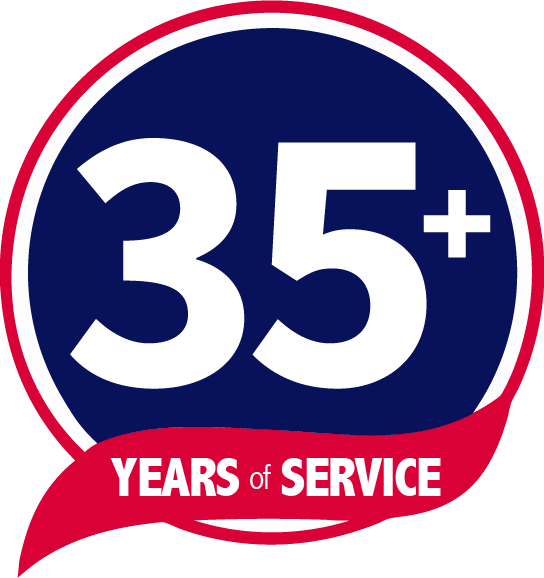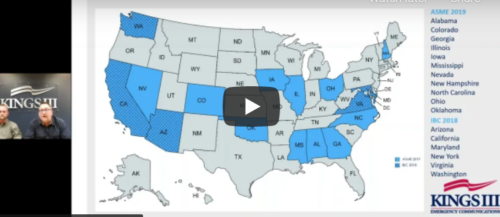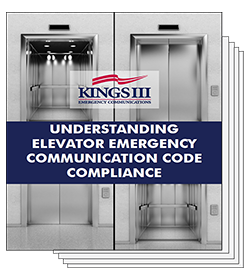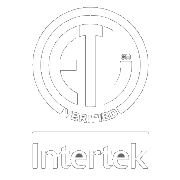What the Latest Elevator Safety Code Says About Your Emergency Phones & How CabView™ Can Help
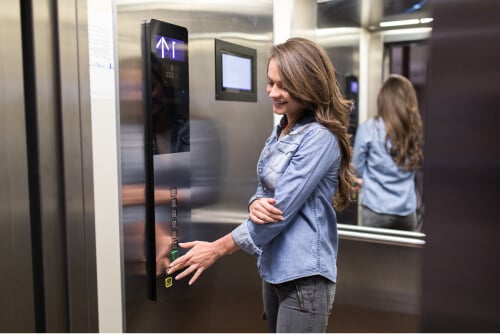
The end of 2019 brought us the publication of the updated ASME A17.1/CSA B44 Safety Code for Elevators and Escalators. As is common with any code revision, we received many inquiries from our customers, equipment owners, and technicians/installers asking, “What does this mean for me, and when do elevators need to comply with the updated code?”
First things first: This page focuses on information related to the 2019 ASME A17.1 elevator code updates, which may not currently apply to everyone. It’s crucial to understand that the specific requirements to meet elevator code can vary by state, depending on the code year your state adopts; there is no one national elevator safety code to rule them all. To find the applicable code year in your location and specific requirements for your emergency elevator phones, visit our table further down the page and select your state. Of course, it’s always beneficial to be familiar with ASME elevator code changes that your state will likely adopt in the future. Read on for more information on the new elevator code changes related to emergency elevator phone monitoring and capabilities.
Looking for information on elevator video communication in regards to the 2018 International Building Code update? Get your info here.
Now let’s get down to the changes– You can find a bulk of the updated language in Section 2.27.1: Car Emergency Signaling Devices.
ASME A17.1/CSA B44 2019, Section 2.27.1: Car Emergency Signaling Devices has been updated to require:
- Two-way message display in the elevator cab to ensure communication for hearing and/or speech-impaired passengers
- A means for authorized emergency personnel to view video footage of passengers anywhere in the cab, strengthening elevator emergency phone requirements for enhanced monitoring and response
- A feature that allows authorized emergency personnel to change the cab message to indicate that help is on-site, which is critical for elevators with over 60 feet of travel
See our Understanding Elevator Emergency Communications Code PDF for a comprehensive understanding of elevator phone requirements.
What does this mean? The key distinction with the recent updates to elevator monitoring requirements is the addition of specific guidelines on how those responding to elevator entrapment calls communicate with passengers inside the cab. While two-way communication has always been critical, the new language in ASME A17.1 code ensures that elevator riders receive more effective assistance when needed. These code updates were implemented with elevator ADA compliance in mind to better assist individuals who are deaf, hard of hearing, or speech impaired, but they will also improve communication for all calls placed from an elevator phone, especially in the case of frequent false alarms.
We’ve all seen it—someone accidentally presses the elevator help phone button, and passengers either ignore it or leave the elevator. What happens if the monitoring station doesn’t get a response? With up to 1,000 false calls daily, the updates to elevator emergency phone requirements are designed to help monitoring stations distinguish between real emergencies and accidental calls. This clarity prevents unnecessary dispatches while ensuring help is delivered when truly needed.
These changes are designed to provide peace of mind, not only for those calling for help but also for those answering. If a passenger does not or cannot respond– possibly because they are speech- or hearing-impaired– the new ASME elevator code updates allow emergency personnel to communicate using nonverbal methods. Real-time messages can be displayed in the cab, and passengers can respond “yes” or “no” using the “Door Open” and “Door Closed” buttons. This system improves communication, ensuring everyone can get the help they need during an emergency.
GET INFORMATION ABOUT MUST-KNOW ELEVATOR CODE UPDATES
WEBINAR: Three Things You Need to Know About ASME/IBC Elevator Communication Code Updates
The latest ASME/IBC code updates bring significant changes to elevator phone line code requirements and will have a major impact on your elevator emergency communication system. Join our live webinar and Q&A to get a full breakdown from our experts, including our in-house qualified elevator inspector and a member of the ASME Electrical Code Committee.
ASME A17.1 Video Communication
The new elevator monitoring requirement for a one-way elevator video communication stream enhances elevator emergency phone requirements by allowing emergency personnel to see inside the elevator, enabling them to better assess situations, such as identifying if a passenger is unable to respond due to a disability or incapacitation. Live, encrypted video of the elevator interior can be accessed by the remote monitoring station, local fire control panel, or building security desk. Kings III can provide a reliable cellular data connection to meet the more complex set of deliverables and additional post-installation responsibilities that the new emergency elevator phone requirements demand.
Meet The New Two-Way Video & Messaging Elevator Code
Our best-in-class emergency phone + monitoring solutions provide peace of mind and are backed by decades of expertise-now compatible with video and messaging systems
Learn MoreBelow, you can find an overview of ASME A17.1 elevator code requirements by year, including those updates made in 2019.
Select your state to highlight the ASME code year that the state follows.
As shown, the specific requirements to meet elevator code vary by state. Additionally, like most updates, the new ASME elevator code requirements will only apply to elevators permitted for construction or modernization after AHJ adoption. However, building owners may choose to upgrade older or non-modernized elevators to ensure consistency across emergency communication systems. When the code applies to you, will you be ready to meet the new elevator phone requirements? Many companies offer call monitoring and answering services, but if elevator emergency calls aren’t their primary business, will they be able to handle the new logistical challenges? Here are some items to consider:
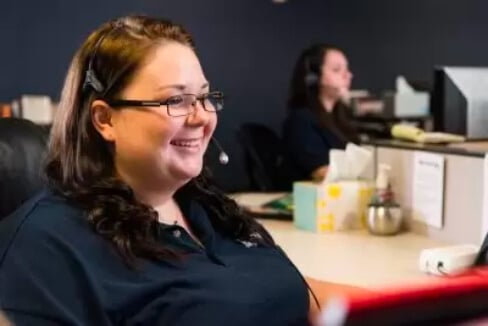
- Does my monitoring solution have a backup plan when there is a power outage? Does it have its entire internet network infrastructure on 4-hour battery backup (as per the code revision)?
- Does my 24/7 monitoring solution have built-in redundancy? Can it still answer video and messaging calls any time of day or night, even when its IT department takes down the internet connection for networking maintenance, the occurrence of a connectivity issue via telecom or some other run of the mill mishap, or even a natural disaster?
- Is the internet service provider I use reliable and secure?
- Is my elevator phone’s monitoring center set up with equipment to monitor video? Does it have the means to back up the messaging and text messages, and store them for legal reasons?
- Is my elevator phone monitoring team consistently trained to answer calls, including video and messaging? Is there a chance the video and messaging system will accidentally not be used when it could have been, which could lead to liability issues?
- See a comprehensive list of items to consider here: Kings III’s Recommended Minimum Standards for Emergency Elevator Phone Monitoring
Meeting ASME 17.1 2019 Elevator Code Requirements
Kings III has been actively collaborating with MAD Elevator to address the latest elevator phone line code requirements. Our Kings III phones and CabView elevator video monitoring systems are fully compatible with video messaging components and fixtures from a variety of manufacturers. This allows us to leverage our existing code-compliant phones while maintaining the all-inclusive monitoring benefits alongside the new two-way video features.
When our Kings III Emergency Dispatch Center (EDC) is alerted to an entrapment, we can seamlessly connect to the elevator car camera to enhance our audio communication. This integration not only meets the updated elevator emergency phone requirements but also ensures that our systems are equipped to handle evolving safety standards.
What It Looks Like in a Compatible Two-Way Video Elevator System
- An elevator passenger places an emergency call by pressing the phone/help button.
- A phone call is placed to the monitoring station through the existing emergency phone system. At the same time, an encrypted tunnel is opened to the monitoring station for video and messaging.
- The monitoring station answers the phone and begins a verbal conversation with the passenger.
- If the passenger does not respond, the monitoring station can visually confirm via the in-car elevator camera if there is a passenger in the car, and that it was not an accidental button press.
- If a passenger is present and has not acknowledged spoken communication, the monitoring station can try to communicate by posting written messages to the in-car screen.
- Passengers can either respond verbally or by pressing door open/close buttons to answer “yes” or “no.”
- If there is still no response (or the passenger is unable to respond), the visual confirmation of a passenger being present enables the monitoring station to dispatch appropriate emergency personnel.
This process aligns with the latest elevator phone line code requirements and enhances overall safety by ensuring that emergency communication systems are responsive and effective.
What it Looks Like with Kings III’s CabView Elevator Video Monitoring
- Our CabView system monitors the phone/help button through a second contact.
- When a passenger presses the button, the monitoring center system is notified, and video and text message call requests are created for that specific elevator, adhering to updated elevator emergency phone requirements.
- The phone call comes in and is answered by a Kings III Emergency Dispatcher.
- Upon accepting the video and message request, an encrypted tunnel is established between the monitoring station and the elevator system, enhancing security and functionality in line with elevator phone line requirements.
- Through this tunnel, the Kings III Emergency Dispatcher reviews the video feed and communicates to the car and through the two-way text messaging.
This non-proprietary solution avoids the pitfalls of restrictive equipment, making it compatible with any open platform system. In contrast, many external systems rely on proprietary equipment that can limit your options for elevator service companies and may lock you into permanent maintenance contracts. With Kings III, you gain flexibility and peace of mind, knowing your emergency communication system meets essential elevator phone requirements while remaining adaptable to your needs.
What it Looks Like with an Internally Monitored System
How does this work in a building with 24-hour onsite security staff who monitor internally? For this type of system, an external connection to the internet and creation of the encrypted tunnel is not required, since all devices are on the same network. When the button is pressed, an onsite attendant is notified via video and messaging software on the fire panel/security desk.
What You Should Consider
Regardless of the code year adopted by your state, the need to protect your customers and those who ride in their elevators remains paramount. As regulations evolve, monitoring requirements grow stricter, and inspectors demand more thorough compliance. With the integration of video and messaging capabilities, elevator companies are increasingly evaluating whether to continue in-house monitoring or to partner with experts, as self-monitoring can often become an unnecessary distraction. Many elevator companies have chosen to collaborate with Kings III for specialized emergency elevator phone monitoring services that meet current elevator phone line code requirements. Switching between software programs, interfaces, and methods from call to call can complicate the monitoring process. If those answering your elevator phones do not specialize in this area, the potential liability becomes a significant concern.
With approximately 18 billion elevator trips in the U.S. annually, elevator malfunctions are an unfortunate reality. These additional elevator emergency phone requirements make it crucial to have a reliable response plan in place. You can enhance the safety and security of all passengers while minimizing risk for your business.
A Quick Checklist: All Elevator Code Requirements at a Glance
American Society of Mechanical Engineers (ASME) Elevator Code
ASME is often one of the first codes referenced by inspectors when it comes to elevators. Here are the items that they will look for:
- A clean and dry elevator pit and machine/control room provided (ASME A17.1 Rule 2.1.2)
- Machine/control room meets manufacturer’s requirement of preserving ambient temperature control and humidity (ASME A17.1 Rule 2.7.9)
- Elevator floor covering installed with appropriate smoke and flame spread (ASME A17.1 Rule 2.14.2)
- Functioning two-way communication provided (ASME A17.1 Section 2.27)
- Elevator calls directed to a 24-hour live monitoring service that is able to respond to emergencies (ASME A17.1 Section 2.27) *NOTE: NEW IN 2019- If your elevator must meet A17.1-2019 or after, there are some additional emergency communications requirements you will need to adhere to:
- Two-way message display in cab for hearing and/or speech impaired
- Means for authorized personnel to view video of passengers anywhere in cab
- Means activated by emergency personnel to change cab message to indicate help is on-site if over 60 ft of travel
- Smoke detectors located in every lobby and in the elevator machine room, with lobby detectors zoned- no built-in time delay, verification not permitted (Both ASME A17.1 Section 2.27 and NFPA 72)
- “Flashing hat” signal is provided in the elevator in the event that a smoke detector is activated (Both ASME A17.1 Section 2.27 and NFPA 72)
- Any equipment/accessories unrelated to elevator use/function/operation (i.e. pipes, ducts) removed from the elevator space and hoistway (ASME A17.1 Section 2.8)
- Fire extinguisher provided in the machine/control room (ASME A17.1 Rule 8.6)
- Normally operable door closer with self-locking lockset from within machine room provided (ASME A17.1 Rule 2.7.3.4)
- Machine/control room provides 19 foot candles of illumination at floor level (ASME A17.1 Rule 2.7.9)
Reprinted from A17.1-2019, by permission of The American Society of Mechanical Engineers. All rights reserved.
Americans with Disabilities (ADA) Elevator Requirements
ADA helps to ensure that tenants with disabilities have the same access to both elevator usage and safety. Here’s what you need to verify. (Source)
- Elevators located on an accessible route and comply with ASME A17.1 Safety Code for Elevators and Escalators- freight elevators not included (ADA 4.10.1)
- Each elevator car is equipped with an automatic self-leveling feature independent from the elevator operating device that brings cars to floor landings 1/2″ under rated loading to zero loading conditions (ADA 4.10.2)
- Elevator call buttons are centered at 42” above the floor (ADA 4.10.3)
- Elevator call buttons have visual signals that notify when a call is both registered and answered (ADA 4.10.3)
- Elevator call buttons are no smaller than ¾” (ADA 4.10.3)
- Elevator call buttons are raised/flush (ADA 4.10.3)
- Any objects below elevator call buttons do not project into the lobby more than 4” (ADA 4.10.3)
- There is a visible and audible signal at every hoistway that communicates which elevator will be answering the call (ADA 4.10.4)
- Audible signals: either sound once to indicate up and twice to indicate down, or use verbal announcements that state “Up” and “Down”
- Hall lantern fixtures’ center lines are located at least 72” above the floor
- Visual elements are no smaller than 2 ½”
- Raised and Braille floor indications are provided on all elevator hoistway entrances on both jambs (ADA 4.10.5)
- Character centerline is 60” above finish
- Characters are 2” high
- Elevator doors open and close automatically, included with an automatic device that stops and reopens car and hoistway door if door is obstructed by object or person without requiring contact (ADA 4.10.6)
- Door devices remain effective for at least 20 seconds
- Elevator doors close at the appropriate minimum acceptable time after the time of an indicated elevator notification (ADA 4.10.7)
- The minimum time for elevator doors to remain fully open in response to a car call is 3 seconds (ADA 4.10.8)
- Space is provided for a wheelchair user to enter, reach controls and exit the elevator car (ADA 4.10.8)
- Door opening is at least 36”
- Cab length is at least 51” with at least 54” from the back of the cab to the face of the door
- Cab width for side opening doors is at least 68”
- Cab width for center opening doors is at least 80”
- Floor surfaces are slip resistant (ADA 4.10.10)
- If carpet is used it has ½” pile thickness or lower and all exposed edges are fastened with carpet edge trim
- At least 5 foot candles are used for car controls, platform, car threshold and landing sill (ADA 4.10.11)
- Meets car control panel requirements (ADA 4.10.12)
- Control buttons are raised/flush and are at least ¾”
- Control buttons are designated by Braille
- Floor buttons for side approach are 54” or lower above finish floor
- Floor buttons for front approach are 48” or lower above finish floor
- If car has center opening doors, controls are located on front wall
- If car has side opening doors, controls are located on front wall next to door or side wall
- A visual indicator is provided above the car’s control panel to relay the position of the elevator within the hoistway with corresponding numbers that illuminate and an audible signal as each floor is passed or stopped on (ADA 4.10.13)
- The highest operable part of an elevator’s two-way emergency communications system is 48” or lower from the floor of the elevator car (ADA 4.10.14)
- The elevator’s two-way emergency communications system is established by a raised/recessed symbol and lettering adjacent to the device (ADA 4.10.14)
International Building Code Elevator Regulations
The International Building Code is updated every year. Here’s a more recent development below.
- Elevator machine/control room venting has appropriate fire dampers in penetrations
- Depending on the location, smoke dampers are installed in machine/control room venting
- If floor is one or more stories above or below the level of exit discharge, a two-way communication system is provided at the landing serving each elevator or bank of elevators
See more here.
National Electric Code Elevator Regulations
We’re in the home stretch! There are a few things regarding your NEC elevator code that you will want to check: (Source)
- Ground-fault circuit interrupter (GFCI) protected, receptacle outlets are provided in the pit and the machine/control room (NEC 620.23 ( c ), NEC 620.4 ( c ), NEC 620.85)
- Car lights and receptacles are on a 15AMP separate branch circuit with a lockable over current protecting device located in the machine room (NEC 620.22, NEC 620.53)
- Over current protecting device is externally operable, fused/thermally protected, lockable disconnecting means (NEC 620.22, NEC 620.53)
- There is a separate branch circuit for the machine room light and receptacles (NEC 620.23)
- There is a separate branch circuit for the pit light and receptacle with at least 10 foot candles (NEC 620.24)
Checking off the items on this list will help you to ensure that you have met important national elevator codes. NOTE: It is important to check your state building codes as well, as they may have further elevator code requirements.
Some Commonly Asked Questions About Elevator Safety Codes in General
- What do I need to know about elevator safety codes?
Elevator safety codes hold building owners and property managers responsible for meeting certain requirements within the elevators, or lifts, on-site to help ensure the safety of all elevator occupants. Those who do not meet elevator safety code requirements face fines and can even be subject to litigation. While specific elevator safety code requirements can vary at the state and local levels, the three main codes that address elevator safety include the American Society of Mechanical Engineers (ASME), the International Building Code (IBC), and the Americans with Disabilities Act (ADA).
These regulations specify necessary features, such as two-way communication and video monitoring, to enhance passenger safety. Understanding the elevator emergency phone requirements is vital for fulfilling legal obligations and improving emergency response capabilities. Note that the terms "elevator" and "lift" are interchangeable, and you will see both used regularly in elevator-related content. -
What is the ASME elevator safety code?
The American Society of Mechanical Engineers (ASME) is a globally recognized source of consensus standards founded in 1880 with a primary goal to protect the public. ASME Elevator safety code is referenced in ASME a17.1, which references Emergency Operation and Signaling Devices (elevator phones).
-
What are the necessary requirements to meet the elevator code?
The specific requirements to meet elevator codes can vary by state. To get detailed information regarding your elevator phone line requirements, visit the Code Compliance section of our website. Here, you can select your state and access tailored information related to your emergency elevator phones. Other elevator safety code information can be found here. For instance, Texas and Georgia are currently following ASME 2016 standards, while California is adhering to ASME 2004. Notably, North Carolina and Alabama were among the first states to adopt the 2019 code, which includes updated provisions for elevator phone requirements, such as video communication capabilities.
-
What Is ASME a17.1-2019?
ASME a17.1-2019 is a part of the American Society of Mechanical Engineers (ASME) code, developed by 5800 experts in 60 countries. ASME serves a wide-ranging engineering community and is instrumental in the development of codes and standards with a primary goal to protect the public. ASME a17.1 specifically addresses Emergency Operation and Signaling Devices, to ensure that elevator phone requirements are met to enhance passenger safety. Various versions of ASME are classified by the year they were amended, with enforcement typically occurring at the state level. ASME A17.1-2019 is the most recent version, and it includes important updates regarding elevator phone line code requirements and elevator emergency phone requirements. By staying informed about these regulations, building owners can ensure compliance and provide safe, reliable communication systems for elevator occupants.
-
My state adopted IBC 2018, but not ASME 2019. Should a solution that is built for and meets ASME 2019 pass inspection?
Yes, because ASME A17.1/B44 is the referenced standard in IBC 2018. More info on IBC 2018 here
- Does ASME 2019 address the same requirements as IBC 2018?
Yes, the video and non-verbal communication requirements outlined in ASME A17.1/CSA B44, Sec. 2.27.1.1.3 through 2.27.1.1.4 were developed specifically to address the standards set forth in IBC 2018 Sections 3001.2 and 3001.3, including Table 3001.3. This table establishes the applicable standard for compliance with ASME A17.1/CSA B44, ensuring that all elevator phone line requirements are met effectively. More info on IBC 2018 update here.
-
What codes pertain to elevator safety?
While specific elevator safety code requirements can vary at the state and local levels, three key codes govern elevator safety: the American Society of Mechanical Engineers (ASME), the International Building Code (IBC), and the Americans with Disabilities Act (ADA).
For more detailed guidance on ensuring compliance with elevator phone line requirements and other codes, you can explore these helpful resources: -
How is ASME a17.1-2019 different from previous versions?
The key difference between ASME a17.1-2019 from previous versions is the added focus on elevator safety for hearing and/or speech impaired passengers. At a basic first glance, here are the new additional requirements:
- There must be a two-way message display in the elevator cab for hearing and/or speech impaired passengers
- There must be a means for authorized personnel to view video footage of passengers anywhere in the elevator cab
- There must be means activated by emergency personnel to change the elevator cab message to indicate that help is on-site if over 60 feet of travel
When does this apply? As with other elevator phone line code requirements, new standards are adopted on a state-by-state basis. For states that have adopted the 2019 code, these inclusions apply only in the case of new construction or elevator modernization/elevator alteration as defined by your local Authority Having Jurisdiction (AHJ). See more information on the 2019 ASME update here. -
How can I know if my elevators meet the safety standards?
Use this quick and easy elevator code checklist to help ensure your elevator meets the safety standards required by code. Keep in mind that elevator emergency phone codes can vary by state, as different states adopt different code years. Not all have yet implemented the 2019 updates focused on ASME A17.1, which emphasize elevator phone requirements like video communication.
-
How do I get the latest elevator code?
Look to the National Elevator Industry, Inc. (NEII) for details on which states follow which specific elevator codes. For the latest updates on elevator emergency phone requirements, visit the Code Compliance section of our website. You can buy the Handbook on Safety Code for Elevators and Escalators directly from ASMEs website. Additionally, the American National Standards Institute (ANSI) is another resource for accessing standards and code-related information.



